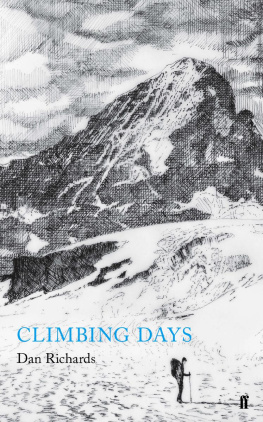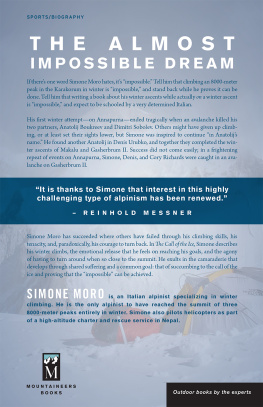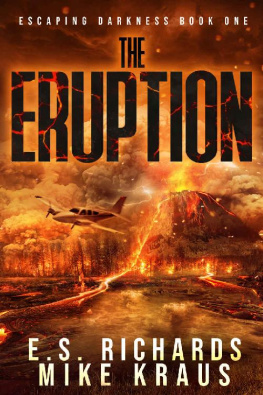Dan Richards - Climbing Days
Here you can read online Dan Richards - Climbing Days full text of the book (entire story) in english for free. Download pdf and epub, get meaning, cover and reviews about this ebook. year: 2016, publisher: Faber & Faber, genre: Art. Description of the work, (preface) as well as reviews are available. Best literature library LitArk.com created for fans of good reading and offers a wide selection of genres:
Romance novel
Science fiction
Adventure
Detective
Science
History
Home and family
Prose
Art
Politics
Computer
Non-fiction
Religion
Business
Children
Humor
Choose a favorite category and find really read worthwhile books. Enjoy immersion in the world of imagination, feel the emotions of the characters or learn something new for yourself, make an fascinating discovery.
- Book:Climbing Days
- Author:
- Publisher:Faber & Faber
- Genre:
- Year:2016
- Rating:4 / 5
- Favourites:Add to favourites
- Your mark:
- 80
- 1
- 2
- 3
- 4
- 5
Climbing Days: summary, description and annotation
We offer to read an annotation, description, summary or preface (depends on what the author of the book "Climbing Days" wrote himself). If you haven't found the necessary information about the book — write in the comments, we will try to find it.
Climbing Days — read online for free the complete book (whole text) full work
Below is the text of the book, divided by pages. System saving the place of the last page read, allows you to conveniently read the book "Climbing Days" online for free, without having to search again every time where you left off. Put a bookmark, and you can go to the page where you finished reading at any time.
Font size:
Interval:
Bookmark:

For my family and friends:
the Richards, the Pilleys and the Georges.
I wake early and set out into the shining day with the sun still low behind Pen yr Ole Wen Head of the White Slope which looks a perfect pyramid from the hostel door, a childs drawing of a mountain. The peak casts a deep shadow over the western flanks of Foel-goch to the west and down Nant Ffrancon Pass ahead, but the path that I take from the Ogwen Lake climbs into the sun a land of luminous yellows and violets turning first to face the broken slopes of Tryfan, then sweeping round toward the Glyder massif and the bowl of Cwm Idwal.
As I walk, I pass in the shadow of huge boulders dumped by the Quaternarian glacier which scooped this valley out as it retreated down to Bangor. Monoliths stand about, silent toughs who watch me go. Charles Darwin first noted these perched rocks in 1842 on his second visit to the valley. Returning with a new perspective, having developed what he called a glacial eye, Darwin saw that Cwm Idwal possessed a uniquely rich testimony to the ice that had once filled it: a house burnt down by fire did not tell its story more plainly than did this valley.
One hundred and seventy-one years later the rocks remain distinct, unmoved, their ridged sides flecked with bright lichens except now theres a well-trodden path, buffed by the thousands who pass this way each year, and the rocks are called Darwins Boulders whereas they just were in the 1840s. Further on I find hawkweed and damson-coloured butterwort, sour wood sorrel growing amidst razor-haired grasses. Ogwen is also a rare southern outpost for opalescent arctic moss and alpine saxifrages.
As I reach the lakeside, the wind rises to heckle the collar of my jacket. Out on the water it swoops in bands, strafing silver ripples which track back to the shore. The landscape here is even rockier, the thin skin of plant-life barely covering the igneous alluvium beneath. The underland breaks out at my feet whilst, opposite, Y Garn soars outworks swathed in purple scree stone walls towering all around me, a tiny spider in a rhyolite bath.
Drizzle begins to fall as I pass through a metal gate, the warm light suddenly sucked from the day. The clouds gloom in with a startling speed, like a snap migraine. Before me, the tussocked slope steepens to form a rubble-pocked terrace, rising in irregular rucks. Above this, darker crags slide out of the white clouds which hug the ridgeline and frame the valley head; the parsley fern and mosses stalling on the sharp incline, lush greens fading through stubble to slate.
Still higher, the slopes suddenly flash up pale straw as sun breaks through the grey, the light scanning round like a compass point to settle momentarily on my destination, the Idwal Slabs or Rhiwiau Caws Slopes of Cheese. Today the slabs are a jet wedge angling down, dark grey fingers pushed into the wet earth the rock massed and pleated, already looming massive from half a mile away.
*
Im on the trail of my great-great-aunt, Dorothy Pilley a prominent and pioneering mountaineer of the early twentieth century with her 1935 memoir Climbing Days as my guide. The book details her time climbing in Wales, the Lakes, the Alps and North America with her husband, the literary critic and scholar Ivor Armstrong Richards (I.A.R.); the final chapter is an account of their celebrated first ascent of the north ridge of the Dent Blanche in 1928 one of the last great mountaineering problems of the Alps.
I began this book in China, being homesick for European hills, wrote Dorothy in her Climbing Days preface. It was a substitute for climbs in Britain and the Alps. In the final stages it was only too truly a substitute; stealing away days that might have been spent high, for a low struggle with commas.
Id recently finished writing a book set deep in the overgrown lanes of Dorset; a collaboration with two others, inspired by Geoffrey Households 1939 pulp thriller Rogue Male and the poetry of Edward Thomas. Holloway, as we called it, explored landscape, journeys, paths and interrelation, and left me thinking of my family tree and literary roots since the project had proved a strange and revealing way into the past. Maybe here was a means of approaching the mystery of Dorothy and I.A.R., Dorothea and Ivor; my father remembers her as always aunt Dorothea; Dorothy Pilley on her book jackets; Dorothy Pilley (Mrs I. A. Richards) on the title page of Climbing Days the couple whose several names had long featured in family conversation but whom nobody seemed to have known. Perhaps, in the mountains, I could meet them halfway.
*
Without knowing it, Id practised the close reading advocated in I.A.R.s Practical Criticism throughout my secondary education, and it wasnt until I was studying English Literature at university that I began to understand his importance and contribution. At one point I had the strange experience of sitting through a lecture about him, the professor at the front dismantling Shakespearean sonnets with the semiotic toolkit I.A.R. developed at Cambridge in the 1920s.
Returning home for Christmas after my first term, I discovered other of his books: The Meaning of Meaning and Mencius on the Mind: Experiments in Multiple Definition, unread and shelved away, publishers With Compliments slips still crisp between their pages. First editions given during their stopovers and kept like talismans. Beside them sat Climbing Days Dorothy Pilley, London: G. Bell & Sons Ltd, 1935 bound in Munsell green cloth. In place of a With Compliments slip I found a copy of I.A.R.s poem Hope To D.E.P. in hospital for a broken hip folded up and tucked inside the dust jacket. By whom? I never knew, but I rescued all three books and set them on my bedroom desk and there they rested, occasionally grazed but mostly neglected. It wasnt until I had cause to make a trip to Snowdonia of my own to visit the sculptor David Nash in Blaenau Ffestiniog that, recalling the early pages of Climbing Days, I made a point of sitting down to read it through, together with Roger Deakins Wildwood, in preparation for the trip.
Exploring Climbing Days, I began thinking that, were I not related to Dorothy had I just stumbled upon her writing by chance my feelings about the book might be quite different. Id have probably just taken the writing at face value and enjoyed the escapades, but the fact Dorothy was a peripheral and mysterious presence coloured her words. I.A.R., for instance, turns up early on and is described as lean, athletic and logical in his approach, calm and agile: often seeming to choose footholds up round his ears. Dorothy is factual rather than fervent in her descriptions of him and whilst theres definite admiration there are few hints of a relationship developing. Friends, comrades, the sort to use last names and punch each other on the arm, although, after theyve scaled Hope together, she writes that all through the winter I.A.R. sent her drawings of the cliffs above with new suggestions for attempts. A correspondence had been established away from Wales: Pilley in London, Richards in Cambridge.
But exultant language is reserved for the mountains, and events beyond their border are touched upon rarely; as if Dorothy enters a state of suspended animation at Bangor railway station, resigning herself to a sepia spell, truly living only during odd weekends whenever I could fit them in, framed between night journeys in which the endless serried lights of Crewe shunting-yards seemed the great gateway to the hills.
Font size:
Interval:
Bookmark:
Similar books «Climbing Days»
Look at similar books to Climbing Days. We have selected literature similar in name and meaning in the hope of providing readers with more options to find new, interesting, not yet read works.
Discussion, reviews of the book Climbing Days and just readers' own opinions. Leave your comments, write what you think about the work, its meaning or the main characters. Specify what exactly you liked and what you didn't like, and why you think so.








